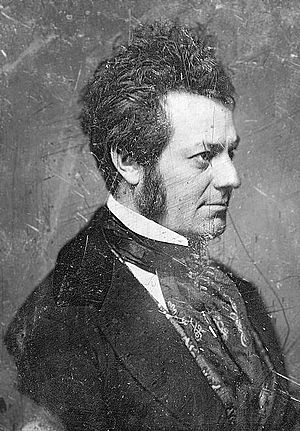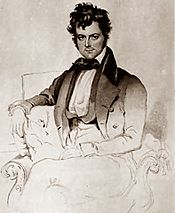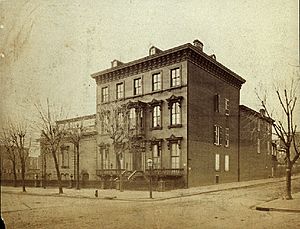Edwin Forrest facts for kids
Quick facts for kids
Edwin Forrest
|
|
|---|---|

A picture of Edwin Forrest by Mathew Brady
|
|
| Born | March 9, 1806 |
| Died | December 12, 1872 (aged 66) Philadelphia, Pennsylvania, U.S.
|
| Occupation | Actor |
| Signature | |
Edwin Forrest (born March 9, 1806 – died December 12, 1872) was a very famous American actor in the 1800s. He was known for playing characters from Shakespeare's plays. A disagreement he had with a British actor named William Macready led to a serious event called the Astor Place Riot in 1849.
Contents
Early Life and First Steps on Stage
Forrest was born in Philadelphia, Pennsylvania. His father, William Forrest, was a Scottish seller of goods. His mother, Rebecca, came from a wealthy German-American family. When Edwin was a boy, he and his brother William joined a local acting club for young people. They put on plays in a simple woodshed.
When he was 11, Edwin first performed on a real stage. He played a girl's role in a play called Rudolph: or, The Robbers of Calabria at a theater in Philadelphia. After his father passed away in 1819, Edwin tried different jobs. He worked as a printer's helper and a ship chandler (someone who sells supplies for ships). His official first performance as an actor was on November 27, 1820. He played Young Norval in the play Douglas at the Walnut Street Theatre.
Starting His Acting Career
At that time, theaters in New York and Philadelphia were full of experienced actors. Most of them came from famous British acting families or had trained in Britain. It was hard for American actors to get big roles. Theater managers often doubted the skills of local talent.
Because of this, Forrest took an offer from Joshua Collins and William Jones. They owned theaters in new cities along the Ohio and Mississippi River valleys. Forrest traveled through rough areas, performing in simple halls. This challenging experience helped him become a stronger actor.
In 1824, he went to New Orleans to join the American Theatre company. There, he started acting in better plays. He began to get good reviews from the audiences. By 1825, he was back in Philadelphia. He then went to Albany, New York, where he learned from famous actors like William Conway.
Becoming Famous in New York
In 1826, Edwin Forrest became very successful at the Bowery Theatre in New York City. He played the main character in Othello. Even though he was offered more money at another theater, he kept his promise to stay. This showed his strong sense of honor, which was a key part of his career.
His success in New York spread to every city he visited. In 1829, he starred as Metamora in the play Metamora; or, The Last of the Wampanoags. After earning good money for a few years, he went to Europe. He wanted to rest, travel, and learn more. Actors and scholars there treated him with great respect.
He returned to Philadelphia in 1831 and continued to have great success. In September 1836, he sailed to England again, this time for work. He performed at Drury Lane as Spartacus in The Gladiator. He also played Macbeth, Othello, and King Lear. He was very popular and met many important people, including other actors like William Macready.
In June 1837, he married Miss Catherine Norton Sinclair, an English singer. They returned to Philadelphia, and people thought their marriage would bring him even more happiness.
Supporting New American Plays
Edwin Forrest started a playwriting contest that ran from 1828 to 1847. The main rule was that the winning plays had to have a lead character that suited Forrest's acting style. The plays often focused on American themes.
The first play to win was Metamora by John Augustus Stone in 1828. The next year, The Gladiator by Robert Montgomery Bird won. Other winning plays included Caius Marcus, Oralloosa, The Broker of Bogota, and Jack Cade. Forrest became known as a great Shakespearean actor. He also became known for supporting new American writers.
The plays Metamora, The Gladiator, and Jack Cade were perfect for Forrest's strong voice and powerful acting. He kept these plays in his performances for the rest of his career.
A Famous Rivalry and a Riot
Forrest visited London again in 1845. He performed at the Princess's Theatre. He was very successful in some roles, but when he played Macbeth, the audience booed. Forrest believed this was because of William Macready, another famous actor. Forrest thought Macready was jealous of him.
A few weeks later, when Macready was performing in Edinburgh, Forrest stood up and booed him. This made the British public and press very upset. The incident damaged Forrest's popularity in Britain.
Their rivalry led to the Astor Place riot in May 1849 in New York City. This public fight made tensions worse in the city. About 10,000 people gathered outside the theater where Macready was performing. They fought with authorities. Many people were hurt during this serious event.
Later Acting Years
In 1853, Forrest performed Macbeth at the Old Broadway Theatre. He was very popular. He also became interested in politics. In 1860, he performed Hamlet in New York, which was one of his most successful shows ever.
Around 1865, he developed a health problem called hereditary gout, which affected his leg. This made it hard for him to walk steadily. His tour in California in 1866 was not successful. He performed his last show in New York in February 1871. The plays were Richelieu and King Lear.
In October 1871, Forrest started his last tour. He traveled to many cities, including Philadelphia, New Orleans, and Boston. On March 25, 1872, he performed Lear in Boston, Massachusetts. He played the part six times. He then tried to perform Richelieu, but he caught a cold and was very ill. This was his last performance as an actor. He later tried to give readings from Shakespeare, but it did not work out.
Edwin Forrest passed away suddenly on December 12, 1872, in his home in Philadelphia. He had earned a lot of money from acting and invested it wisely. He bought a large estate called Fonthill by the Hudson River, which he later sold. In 1855, he bought his mansion in Philadelphia, where he collected a very large library of dramatic books.
Helping Other Actors
Edwin Forrest loved the theater very much. He used his wealth to help other actors. This was especially important in 1865, a time when actors were not always respected.
He let actors stay at his summer home near Philadelphia. After he died, his will stated that a home for retired actors should be created in Philadelphia. This home, called the Forrest Home, helped actors for over 100 years. Today, his name lives on in the Edwin Forrest Wing at the Actors' Fund facility in Englewood, New Jersey.
In the 1920s, two new theaters were designed in his honor. One in New York City and one in Philadelphia were both named the Forrest Theatre. The Philadelphia location is still called the Forrest Theatre. The New York building is now known as the Eugene O'Neill Theatre.
Images for kids
See also
 In Spanish: Edwin Forrest para niños
In Spanish: Edwin Forrest para niños




